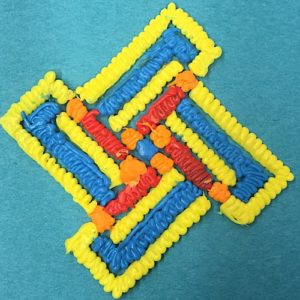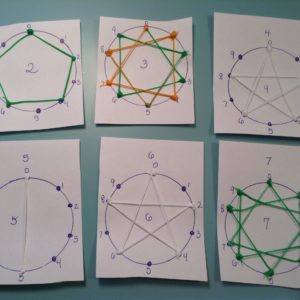MATH: Doodle-Touch-Dots (Addition)
In this activity, students will work in pairs to practice adding numbers from 0-9 using touch dots. Students will add touch dots to numbers, and then doodle their own touch dot numbers to create unique addition problems to solve.

Knowledge
Students have
had practice drawing straight lines, outlines and fill with the 3Doodler.
had practice counting numbers up to 20.
had practice identifying numbers up to 20.
had practice adding using numbers from 1-9.
had practice counting by 2s.
had practice with addition and subtraction.
had practice drawing straight lines, outlines and fill with the 3Doodler.
had practice counting numbers up to 20.
had practice identifying numbers up to 20.
had practice adding using numbers from 1-9.
had practice counting by 2s.
had practice with addition and subtraction.
Objectives
Students will
use touch dots to add numbers from 1-9.
doodle touch-dots on laminated number cards.
doodle touch-dot numbers from 1-9.
create their own addition problems using touch-dot numbers from 1-9.
use touch dots to add numbers from 1-9.
doodle touch-dots on laminated number cards.
doodle touch-dot numbers from 1-9.
create their own addition problems using touch-dot numbers from 1-9.
Materials
Students will need
3Doodler (1 per pair)
Touch-Dot Stencils (#1-5) (Teacher to pre-laminate sheet, one per pair)
Touch-Dot Stencils (#6-9) (Teacher to pre-laminate sheet, one per pair)
3Doodler (1 per pair)
Touch-Dot Stencils (#1-5) (Teacher to pre-laminate sheet, one per pair)
Touch-Dot Stencils (#6-9) (Teacher to pre-laminate sheet, one per pair)
Lesson Plan
Instructions
Step 1
Whole Group: Project Touch-Dot Stencils (#1-5) on the board. Demonstrate how to use the dots to count the value of each number. Have students come up to the board to practice counting using touch-dots, by placing a finger on each dot as it is counted.
Step 2
Use the Touch-Dot Stencils Worksheet (#1-5) to demonstrate how to doodle the dots and practice counting the value of each number with a partner, taking turns.
Step 3
Hand out 3Doodlers and laminated copy of the Touch-Dot Stencils Worksheet (#1-5) to each pair. Circle to assist and assess as students work together to doodle the touch-dot on each number.
Step 4
Call students back to the whole group and project Touch-Dot Stencils (#6-9) on the board. Note that numbers with red-yellow circles are counted by 2s. Have students come up to the board to practice counting touch-dots by 2 by placing a finger on each dots as it is counted. *Note: Instruct students how to add the additional single red dot for #7 and #9 after counting by 2s.
Step 5
Hand out 3Doodlers and laminated Touch-Dot Stencils (#6-9) to each pair. Circle to assist and assess as students work together to doodle the touch-dot on each number.
Step 6
Call students back to the whole group to model how to doodle a number and add touch-dots. Students can use the stencils for numbers 1 through 9, or create their own stencils, depending on their skill levels.
Step 7
Model how to use touch-dot numbers to add. Have students Doodle "+" and "=" signs. Demonstrate how to create 4 different addition problems by rearranging the doodled numbers with the doodled "+" and "=" signs.
Step 8
Circle to assist and assess as students work.
Whole Group: Project Touch-Dot Stencils (#1-5) on the board. Demonstrate how to use the dots to count the value of each number. Have students come up to the board to practice counting using touch-dots, by placing a finger on each dot as it is counted.
Use the Touch-Dot Stencils Worksheet (#1-5) to demonstrate how to doodle the dots and practice counting the value of each number with a partner, taking turns.
Hand out 3Doodlers and laminated copy of the Touch-Dot Stencils Worksheet (#1-5) to each pair. Circle to assist and assess as students work together to doodle the touch-dot on each number.
Call students back to the whole group and project Touch-Dot Stencils (#6-9) on the board. Note that numbers with red-yellow circles are counted by 2s. Have students come up to the board to practice counting touch-dots by 2 by placing a finger on each dots as it is counted. *Note: Instruct students how to add the additional single red dot for #7 and #9 after counting by 2s.
Hand out 3Doodlers and laminated Touch-Dot Stencils (#6-9) to each pair. Circle to assist and assess as students work together to doodle the touch-dot on each number.
Call students back to the whole group to model how to doodle a number and add touch-dots. Students can use the stencils for numbers 1 through 9, or create their own stencils, depending on their skill levels.
Model how to use touch-dot numbers to add. Have students Doodle "+" and "=" signs. Demonstrate how to create 4 different addition problems by rearranging the doodled numbers with the doodled "+" and "=" signs.
Circle to assist and assess as students work.
Wrap Up
Assessment
Possible Extensions
Vocabulary
addition - the act or process of adding.
collaboration - to work jointly with others or together especially in an intellectual endeavor.
counting numbers - Any number you can use for counting things: 1, 2, 3, 4, 5, ... (and so on).
math - the science of numbers and their operations, interrelations, combinations, generalizations, and abstractions and of space configurations and their structure, measurement, transformations, and generalizations.
problem-solving - the process or act of finding a solution to a problem.
skip counting - counting forwards or backwards by a number other than 1.
Educational Standards
Relate counting to addition (e.g., by counting on 2 to add 2).
Students will count on touch-dots by 2's with numbers 6-9.
Use addition within 20 to solve word problems involving situations of adding to, taking from, putting together, taking apart, and comparing, with unknowns in all positions, e.g., by using objects, drawings, and equations with a symbol for the unknown number to represent the problem.1
In the extension activity, students will use doodled touch-dot numbers to create and solve their own word problems.
Decompose (break down) a larger problem into smaller sub-problems with teacher guidance or independently.
Students will break down the process of learning the addition strategy of counting-on numbers using doodled touch-dot numbers.
Use technology to seek feedback that informs and improves their practice and to demonstrate their learning in a variety of ways.
Students will use the 3Doodler to practice adding touch-dots to numbers 1-9 and then doodle their own set of touch-dot numbers 1-9.
Create original works or responsibly repurpose or remix digital resources into new creations.
Students will use their doodled touch-dot numbers to create and solve their own original addition problems.
Use collaborative technologies to work with others, including peers, experts or community members, to examine issues and problems from multiple viewpoints.
Students will seek feedback from their partner throughout this activity.


